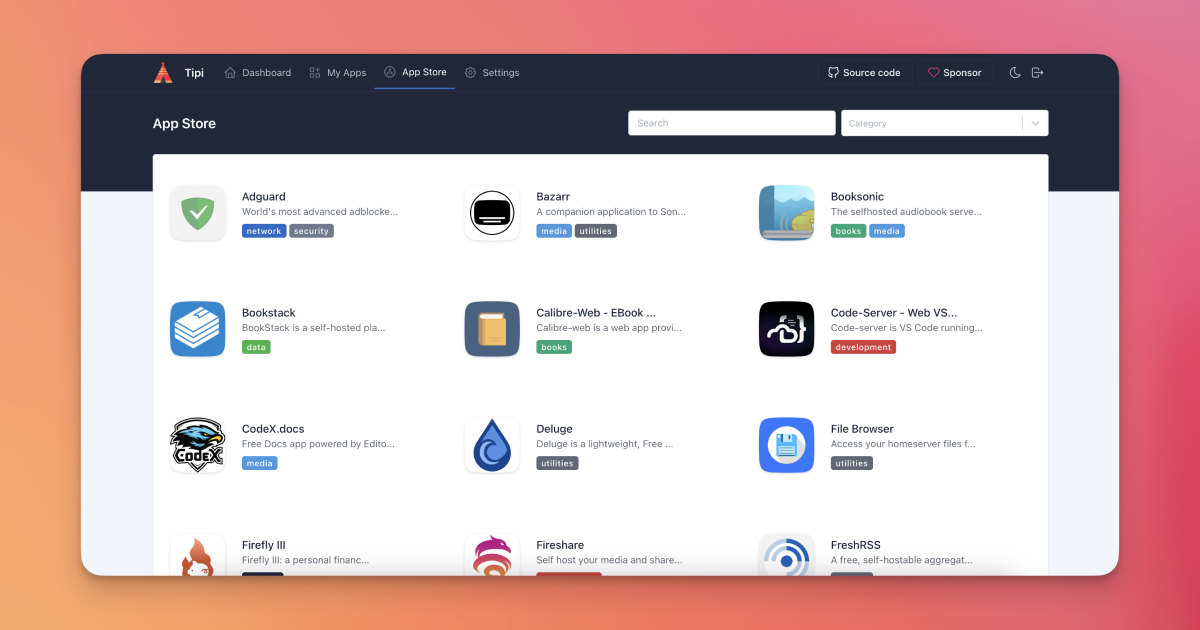- cross-posted to:
- [email protected]
- cross-posted to:
- [email protected]
It has an ‘App store’ that’s been growing a lot lately. Writing new docker-compose.yaml files is easy (see: https://www.runtipi.io/docs/contributing/adding-a-new-app ), and exposing them behind NAT, e.g. from home it’s easy too (see: https://www.runtipi.io/docs/guides/expose-apps-with-cloudflare-tunnels )… But my favorite perk is the folder structure (see: https://www.runtipi.io/docs/reference/folder-structure ), and the fact that ‘media’ is shared between apps.
I’ve been running Tipi for a couple months on a home machine. I don’t have any significant experience with Docker and Tipi was simple enough I could get it running pretty easily.
I use tailscale to access it away from home. I’m running FreshRSS, Invidious, LibReddit, Joplin and Vikunja. Pretty slick!
So I’m the kind of person who runs back ups using two synologies and is more of a GUI guy. I use mac and pcs very fluently but I’m not entirely terminal or command line literal.
Will something like this cause more problems if I’m looking to get rid of Google drive and start switching to next cloud or will this make my life easier?
This requires some command line to fully tame the beast(s)… sorry, the apps! that you’d be hosting. If you prefer an easy solution, for Nextcloud, specifically, I think you can try the managed instances (e.g. Hetzer offers ‘nx’ boxes). It’s better than paying premium fees to GAFAM imho every step counts ;)
deleted by creator
The dashboard, and all apps, have Traefik on top. The certs are generated there. Cloudfare Tunnels is just an option.
deleted by creator
How does this compare to Yunohost?
The most salient difference is that YNHST is tied to Debian, while Runtipi is a set of containers you can install on any distro
These comparisons are extremely difficult to make (not many people really tried all, we all judge from docs, etc.) That being said, I think runtipi is simpler in the curve of customization, if you have the knowledge. If you don’t, well then maybe, a full-blown OS is better. But my original post addressed the advantage I see on runtipi, with all the links to the docs. It’s powerful and encourages customization. To me, it’s a good mid-point between ‘raw’ docker (e.g. linuxserver.io which btw provides most of the images), and a highly automatized system. For example, one of the bigger features is that you can set repositories (e.g. on GitHub) as stores: I will repeat the link to these docs here: https://www.runtipi.io/docs/contributing/adding-a-new-app …over these repos you simply write docker-compose YAML files. I don’t know what’s the solution to this on CasaOS, but YunoHost has a set of scripts or bash functions. That’s something I believe takes more effort to mantain. All in all, imho, runtipi has a good balance between flexibility, complexity, and customization.
What are the pros and cons?
Or casaOS
Hum, the cloudflafe tunnel looks powerfull to bypass a CGNAT !
I’d like to try this, but how will it work alongside my existing setup?
I run NPM to get SSL for my domain, so now there will be two services trying to do the same?
I also run Mattermost which is not in the Store here, so I will still need to run some things outside of this service - while still needing the SSL and reverse proxy.
I haven’t had much luck with app-store-type solutions in the past, but this looks really promising! Thanks for sharing :)






